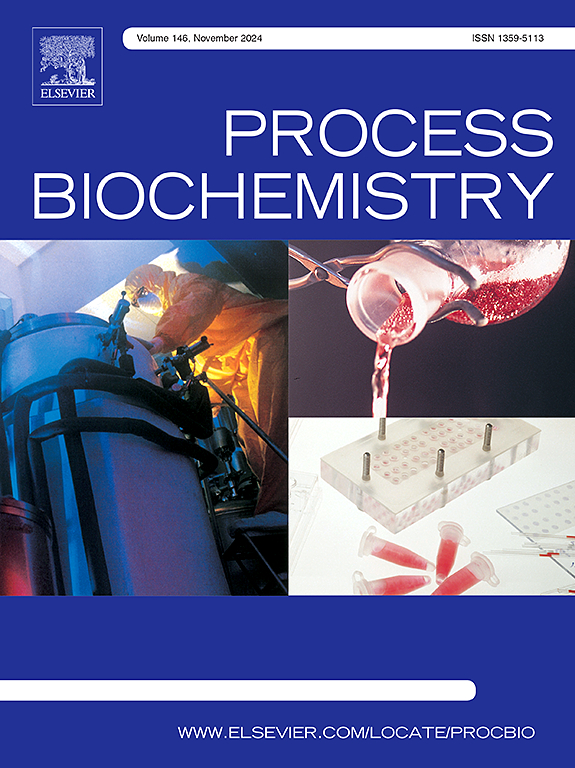Design and development of pilot photobioreactor for simultaneous microalgae cultivation and aquaculture wastewater treatment
IF 3.7
3区 生物学
Q2 BIOCHEMISTRY & MOLECULAR BIOLOGY
引用次数: 0
Abstract
This study presents an innovative and modular phototrophic biofilm photobioreactor (PBR) designed for the simultaneous cultivation of algae and the treatment of aquaculture wastewater (AWW). The vertical flat-plate BPR allows for stable microalgae growth while efficiently removing nutrients from wastewater under controlled conditions, including light, CO2, supplementation, water recirculation and continuous monitoring of parameters such as pH, nitrate (NO3-N) and phosphate (PO43-P). The PBR was operated at an aquaculture facility using AWW, with nutrient removal and microalgal growth being monitored. The microalgae consortium composed of Chlorella sp., Scenedesmus sp. and Phormidium sp. were evaluated for their growth potential and wastewater remediation capabilities. Results showed high nutrient removal efficiencies with 92 % reduction of PO43-P (removal rate: 0.07 mg/L d) and a 62 % reduction of NO3--N (removal rate: 1.1 mg/L d), bringing nutrient concentrations below the limits set by the Waters Protection Ordinance. Maximum biomass production reached a growth rate on land surface of 25 g/m2/d, with a favorable biochemical composition of 51 % proteins, 25 % carbohydrates and up to 8 % lipids, indicating the potential for use animal feed. This study demonstrates the feasibility of using AWW as a growth medium for microalgae while simultaneously achieving wastewater remediation, offering a sustainable solution for nutrient recycling in aquaculture operations.
微藻培养与水产养殖废水同步处理中试光生物反应器的设计与开发
本研究提出了一种创新的模块化光营养生物膜光生物反应器(PBR),用于同时培养藻类和处理水产养殖废水(AWW)。垂直平板BPR允许微藻稳定生长,同时在可控条件下有效去除废水中的营养物质,包括光、二氧化碳、补充、水循环和连续监测pH、硝酸盐(NO3-N)和磷酸盐(PO43-P)等参数。在一个使用AWW的水产养殖设施中操作PBR,监测营养物去除和微藻生长情况。对小球藻(Chlorella sp.)、Scenedesmus sp.和磷藻(Phormidium sp.)组成的微藻群落的生长潜力和废水修复能力进行了评价。结果表明,水体对营养物的去除率较高,PO43-P的去除率为92% %(去除率为0.07 mg/L d), NO3—N的去除率为62% %(去除率为1.1 mg/L d),营养物浓度低于《水域保护条例》规定的限值。最大生物量产量在陆地表面达到25 g/m2/d的增长率,具有良好的生化组成,51 %的蛋白质,25 %的碳水化合物和高达8 %的脂类,表明使用动物饲料的潜力。本研究证明了利用AWW作为微藻生长介质同时实现废水修复的可行性,为水产养殖中营养物的循环利用提供了可持续的解决方案。
本文章由计算机程序翻译,如有差异,请以英文原文为准。
求助全文
约1分钟内获得全文
求助全文
来源期刊

Process Biochemistry
生物-工程:化工
CiteScore
8.30
自引率
4.50%
发文量
374
审稿时长
53 days
期刊介绍:
Process Biochemistry is an application-orientated research journal devoted to reporting advances with originality and novelty, in the science and technology of the processes involving bioactive molecules and living organisms. These processes concern the production of useful metabolites or materials, or the removal of toxic compounds using tools and methods of current biology and engineering. Its main areas of interest include novel bioprocesses and enabling technologies (such as nanobiotechnology, tissue engineering, directed evolution, metabolic engineering, systems biology, and synthetic biology) applicable in food (nutraceutical), healthcare (medical, pharmaceutical, cosmetic), energy (biofuels), environmental, and biorefinery industries and their underlying biological and engineering principles.
 求助内容:
求助内容: 应助结果提醒方式:
应助结果提醒方式:


